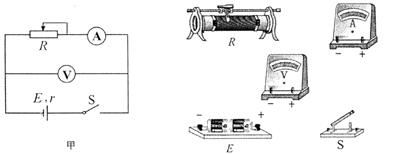(9分)(1)为了测量电源的电动势和内阻,我们通常采用如图甲所示电路,请根据甲电路图连接实物图。

(2)由于电压表和电流表内阻的影响,采用甲电路测量存在系统误差,为了消除这一影响,某同学选择两块量程合适的电压表V1、V2,一个满足实验要求的电阻箱R和三个开关,并设计了如图乙所示的测量电路,进行了如下的主要测量步骤:

①闭合S2,断开S1、S3,记下V1和V2的示数U1和U2;
②断开S2、闭合S3,S1仍断开,调节电阻箱R,使电压表V2的示数仍为U2,读出电阻箱的阻值为R0;
③闭合S1、S2,断开S3,记下V1的示数 ;
;
请利用以上的测量物理量的字母写出电压表V1内阻表达式 =______,该电源的电动势和内阻的测量值表达式E=______,r=______。
=______,该电源的电动势和内阻的测量值表达式E=______,r=______。
(1)电路图连接如图
 ;
;
(2)


题目分析:(1)电路图连接如下图;

(2)设电压表V1、V2的电阻为Rv1、Rv2,由题中条件可知 ,
, ;当闭合S2,断开S1、S3时,由闭合电路欧姆定律,可得
;当闭合S2,断开S1、S3时,由闭合电路欧姆定律,可得 ;当闭合S1、S2,断开S3时,由闭合电路欧姆定律,可得
;当闭合S1、S2,断开S3时,由闭合电路欧姆定律,可得 ,联立以上各式,解得
,联立以上各式,解得 ,
,

 漂白粉可长期放置在烧杯中
漂白粉可长期放置在烧杯中 器灭火,应该用沙
器灭火,应该用沙 子灭火
子灭火 溶液浸湿软布蒙面,并迅
溶液浸湿软布蒙面,并迅 速离开现场
速离开现场